St. Louis, Missouri—Casseroles were once a beloved staple of Baby Boomer cookery.
 For a younger generation of home chefs, however, a thick brick of Tuna Noodle Surprise is regarded as the culinary equivalent of muzak. Just like that all-violin version of “The Way We Were” sawing away in the elevator, casseroles are bland, cheesy, and will probably shorten your lifespan.
For a younger generation of home chefs, however, a thick brick of Tuna Noodle Surprise is regarded as the culinary equivalent of muzak. Just like that all-violin version of “The Way We Were” sawing away in the elevator, casseroles are bland, cheesy, and will probably shorten your lifespan.
These changing tastes are having a profound effect on how the hungry are fed at the St. Patrick Center in St. Louis. The largest provider of homeless services in Missouri, St. Patrick’s offers a variety of housing, employment, and mental health programs, each designed to provide opportunities for self-sufficiency. In addition, the Center serves its at-capacity lunchtime crowd through the Casserole Program, an ingenious food preparation scheme that began in 1984 and has operated continuously ever since.
For a dish that seems so uniquely American, even Middle-American, it is surprising to be reminded that the word, casserole, is of French derivation.
How it works is marvelously simple. St. Patrick’s has an ample supply of pans, as well as easy-to-follow recipes for such classic dishes as Baked Ziti, or Ratatouille. Each volunteer buys her own ingredients and cooks the dish in her own kitchen, so there are no costs to St. Patrick’s. (I say “her” because the vast majority of volunteer chefs are women). She then freezes the casserole and delivers it, cold, down to the Center. Each morning, other volunteers arrive and pop the pans into the oven; forty-five minutes or so later, approximately 250 people are served a nourishing, hot meal.
I thought this was an interesting story, and decided to learn more. What I discovered, however, is that after having passed its 25th anniversary, the Casserole Program was starting to unravel a bit. “We are experiencing attrition,” admits Kelly Peach, the St. Patrick Center’s Senior Director of Communications. “The people who have traditionally made our casseroles were in their forties and fifties when we began and now, they are aging out. Young women are less likely to know how to cook, and even if they do, they probably don’t normally gravitate towards Chicken Tetrazzini.”
For a dish that seems so uniquely American, even Middle-American, it is surprising to be reminded that the word, casserole, is of French derivation. It means “sauce pan” and usually refers to a large, deep-sided dish which is both a cooking utensil and serving vessel. Of course, France does not have a singular claim to entrees that are prepared in, and eaten from, the same pan. Think of Italian lasagna, a Greek moussaka, a Moroccan tajine, or even an Irish Shepherd’s Pie.
In contrast to these venerable recipes, the popularity of casseroles in the United States occurred fairly recently, and was something of a “perfect storm” created by two quite different inventions. First came the Campbell Soup Company’s creation of Cream of Mushroom soup in 1934. Next was the 1958 introduction of Corningware, a line of pyroceramic cooking dishes created by the Corning Glass works company. These were touted as resistant to “thermal shock,” meaning they could go directly from freezer to oven.
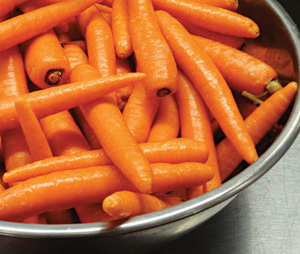 Combined, these two products allowed for low-effort and low-cost meals which could satisfy the largest and hungriest of families. As recipes proliferated, typically they mixed together a starch (rice, pasta, cut potatoes or, lately, Tater Tots) with a protein (ground sirloin, chicken, seafood), and this was held together with some sort of binder like a bechamel (scalded milk mixed with flour and butter) or tomato sauce. If only one dish could be nominated as the classic American casserole, it would doubtless be a frightful, and frightfully tasty, melange of canned green beans, Cream of Mushroom soup, and a crust of French-fried onion rings.
Combined, these two products allowed for low-effort and low-cost meals which could satisfy the largest and hungriest of families. As recipes proliferated, typically they mixed together a starch (rice, pasta, cut potatoes or, lately, Tater Tots) with a protein (ground sirloin, chicken, seafood), and this was held together with some sort of binder like a bechamel (scalded milk mixed with flour and butter) or tomato sauce. If only one dish could be nominated as the classic American casserole, it would doubtless be a frightful, and frightfully tasty, melange of canned green beans, Cream of Mushroom soup, and a crust of French-fried onion rings.
To be sure, I’ve eaten my fair share of casseroles. I grew up in the Conservative Baptist church, where frequent suppers on a Sunday evening featured a smorgasbord of different casseroles aggregated under the optimistic category of “potluck.” I would happily chow down, my paper plate soon a slurry of elbow macaroni, hamburger, red Jell-O, and potato chips—nary a fresh vegetable or piece of fruit in sight. And, if the entire truth be told, I’ve even cooked quite a few casseroles myself, long after I should have known better. I recall a not-too-distant Academy Awards party where I coated a Mac ‘N Cheese dish with a thick lid of butter-soaked breadcrumbs. Forgetting it in the oven for a scant few minutes, this topping dried-out and burned, causing my snootiest of friends to dub my recipe “sawdust pie.”
Wouldn’t it be cool if I came to St. Louis, and she could enlist some of her favorite students to help us cook a meal at a local soup kitchen?
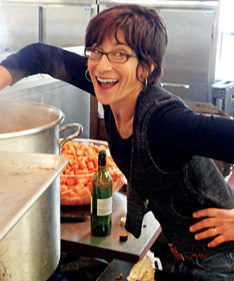 Not a particularly happy memory, and one that might have drifted forever into the mists of time had I not gotten a phone call one day from my pal, Inda Schaenen. A recently-minted Ph.D. from the University of Missouri, St. Louis, Inda had accepted a one-year teaching job at Villa Duchesne, an all-girl’s preparatory school that’s situated in a suburb of St. Louis. Part of a constellation of Sacred Heart Academies (there are Sacred Heart schools in New York, New Orleans, and San Francisco, among many other locations), Inda was amazed, amused, and aghast—all in more or less equal measure—at how deeply conservative and even more deeply Catholic many of her young female students were. “And they’re all so smart and sweet and gorgeous!” she exclaimed.
Not a particularly happy memory, and one that might have drifted forever into the mists of time had I not gotten a phone call one day from my pal, Inda Schaenen. A recently-minted Ph.D. from the University of Missouri, St. Louis, Inda had accepted a one-year teaching job at Villa Duchesne, an all-girl’s preparatory school that’s situated in a suburb of St. Louis. Part of a constellation of Sacred Heart Academies (there are Sacred Heart schools in New York, New Orleans, and San Francisco, among many other locations), Inda was amazed, amused, and aghast—all in more or less equal measure—at how deeply conservative and even more deeply Catholic many of her young female students were. “And they’re all so smart and sweet and gorgeous!” she exclaimed.
It was truly something I needed to see, Inda insisted. Wouldn’t it be cool if I came to St. Louis, and she could enlist some of her favorite students to help us cook a meal at a local soup kitchen?
Yes, I agreed. That sounded like big fun.
Unfortunately, the weekend in Spring which proved most convenient for me fell during the graduation ceremonies at Villa Duchesne. An already fretful time that was complicated further by the school’s super-special tradition of an annual Maypole dance by the senior class. About this, more in a moment. For now, suffice it to say that these young ladies take their seasonal choreography very seriously. So much so, it seemed doubtful Inda would be able to get too many students interested in soup kitchen duty. Instead, she dragooned Liz, another English teacher at Villa Duchesne, and Liz’ husband, Stephen, to be my sous-chef. I was happy to have them.
 There’s something about bulk food purchases that always incites curiosity. We live in fractious times, all of us separated into private little domiciles with our own kitchens, cooktops, refrigerators and fry pans. We rarely cook for large groups, in other words. Not to mention that many people tend to eat out more, and cook less. So, when they do go to the grocery store, they’ll often buy just enough for their next meal. All this to say, a grocery cart loaded with 25 pounds of onions, 50 pounds of carrots; 60 pounds of cubed stew meat, 30 heads of Romaine lettuce, ten heads of purple cabbage; a dozen pineapples, and container after container of strawberries and blueberries, is a provocation of sorts. It hints something out of the ordinary is about to occur—a party, a picnic, or even a setting off to some place where food may be scarce.
There’s something about bulk food purchases that always incites curiosity. We live in fractious times, all of us separated into private little domiciles with our own kitchens, cooktops, refrigerators and fry pans. We rarely cook for large groups, in other words. Not to mention that many people tend to eat out more, and cook less. So, when they do go to the grocery store, they’ll often buy just enough for their next meal. All this to say, a grocery cart loaded with 25 pounds of onions, 50 pounds of carrots; 60 pounds of cubed stew meat, 30 heads of Romaine lettuce, ten heads of purple cabbage; a dozen pineapples, and container after container of strawberries and blueberries, is a provocation of sorts. It hints something out of the ordinary is about to occur—a party, a picnic, or even a setting off to some place where food may be scarce.
This last connotation takes on special relevance, of course, in St. Louis, the so-called “Gateway to the West.” The ghosts of Lewis and Clark still linger here and, even today, St. Louis feels something like the last outpost of civilization before the Wild West. An old joke in these parts has it St. Louis is the only town in the world that would build a monument—the famous arch, designed in 1947 by Eero Saarinen—to those who are leaving town, not staying.
As such, I wasn’t completely surprised, while I loaded up my third cart—this one nearly full with bags of Idaho potatoes—that someone would ask me, “Where you headed off to? You going camping?”
“I’m not,” I replied. “Just making lunch for friends.”
The guy laughed. “You must have a fuck-load of friends.”
This elegant turn of phrase demanded no reply. I smiled, and moved on.
My rental car loaded up, I drive into downtown St. Louis, where I’m met at the St. Patrick Center’s loading dock by a young, very tall and quite pretty P.R. girl named Kristen Bracken. She has arranged for several strong men to unload all the provisions. While they do so, Bracken takes me on a tour of the Center. She is at pains to explain all the opportunities provided for the homeless to get their lives and bodies realigned—including, I am surprised to hear, an on-staff chiropractor.
“If you think about it, people who live on the street carry all their belongings with them, often strapped to their backs. This can take quite a toll on their spinal columns,” she explained.
“Well, yes,” I said. “Of course.”
After we see the Homeless Veterans Re-integration area, a “Go! Network” program that teaches job-seeking techniques, and a Living Skills Laboratory that instructs on basic necessities of how to set up a household, we arrive on the fourth-floor, and the BEGIN new venture center, which is where I would cook for tomorrow’s lunch. I was bending the rules here. Due to its Casserole Program, St. Patrick Center is not set up to have large quantities of meals cooked in its downstairs kitchen, which is basically a glorified warming area, off the dining room. Instead, an exception had been made for me so that I could work in BEGIN, a small business incubator that has a complete restaurant-grade kitchen. When I arrived, I found this space empty save for a woman who was making large trays of frijoles negros, I guessed for some chain of Mexican restaurants around St. Louis. She didn’t speak much English, and my Spanish failed me.
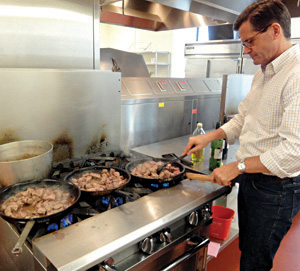 Inda was running late, but would show up shortly. Liz and Stephen and I get to work unpacking and organizing all the groceries. Liz taught English at Villa Duchesne for nearly 30 years, but had recently retired. Stephen sold medical supplies, traveling all over the midwest. Both are Catholic, both were single until their early 40’s when, one day, they met at church, fell in love, and got married.
Inda was running late, but would show up shortly. Liz and Stephen and I get to work unpacking and organizing all the groceries. Liz taught English at Villa Duchesne for nearly 30 years, but had recently retired. Stephen sold medical supplies, traveling all over the midwest. Both are Catholic, both were single until their early 40’s when, one day, they met at church, fell in love, and got married.
Stephen told me all this with a shy smile.
“Not at church, Sweetie,” Liz corrected her husband. “It was a fundraiser for the church.” It seems an important distinction for Liz, as if meeting at church was too geeky for her taste.
We tweak our life narratives the best we can, don’t we?
While they work, Liz and Stephen refer to each other, always, as “honey” and “sweetie.” It should be nauseating, but it’s not. Instead, I am touched by their having found each other so late in life. It doesn’t happen this way too often; they know it, and appear to revel in their good fortune.
To everyone’s surprise, Tim, a young professor of World Religions at Villa Duchesne, shows up. I get him started washing and peeling potatoes, while making a lame joke about KP duty, or the penalty men in the military used to pay for minor infractions of behavior. Tim, who is maybe 25, smiles but I sense he has no idea what I’m talking about now that U.S. Armed Forces have outsourced their food preparation to Halliburton, who build replicas of KFC and Pizza Hut in the fortified “Green Zones” where American soldiers live. Does anyone peel a potato in Iraq or Afghanistan? I’ll have to find out some day.
I’d decided to make Julia Child’s famous recipe for Boeuf Bourguignon, scaling up the ingredients necessary to feed eight, to enough for 300.
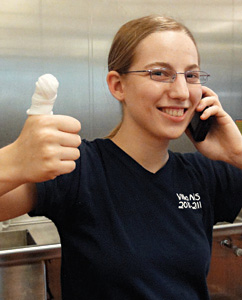 Rounding out our crew was Mariah Mullins, the lone Villa Duchesne student of Inda’s who managed to make it. Mariah is also one of the few graduating seniors who would not be dancing in the Maypole festivities later that evening. She is a quiet, serious young woman who plays the Irish harp. Before I set her to work on slicing carrots, I warn about about safety issues, especially since the cutlery we’re working with is dull. Well, poor Mariah cut about three carrots before her knife slipped, and nearly severed her thumb, the blade going through her fingernail. This must have been incredibly painful, but Mariah completely underplayed the gravity of her wound, calmly asking Inda if she might have a Band-Aid. Maybe two? Thus sutured, she telephoned her father, who was a nurse, and he told her to keep her hand above her head. Incredibly, Mariah continued to work all day, one handed, doing whatever she could—stirring, squeezing lemons, de-stemming rosemary leaves, peeling garlic. I was impressed.
Rounding out our crew was Mariah Mullins, the lone Villa Duchesne student of Inda’s who managed to make it. Mariah is also one of the few graduating seniors who would not be dancing in the Maypole festivities later that evening. She is a quiet, serious young woman who plays the Irish harp. Before I set her to work on slicing carrots, I warn about about safety issues, especially since the cutlery we’re working with is dull. Well, poor Mariah cut about three carrots before her knife slipped, and nearly severed her thumb, the blade going through her fingernail. This must have been incredibly painful, but Mariah completely underplayed the gravity of her wound, calmly asking Inda if she might have a Band-Aid. Maybe two? Thus sutured, she telephoned her father, who was a nurse, and he told her to keep her hand above her head. Incredibly, Mariah continued to work all day, one handed, doing whatever she could—stirring, squeezing lemons, de-stemming rosemary leaves, peeling garlic. I was impressed.
Liz chopped onions, Stephen diced carrots, Tim peeled potatoes, and Inda washed and shredded salad greens. I went to work browning the beef, working with three not very high-quality fry pans. I’d decided to make Julia Child’s famous recipe for Boeuf Bourguignon, scaling up the ingredients necessary to feed eight, to enough for 300. So, I dusted the stew meat pieces with flour, salt and pepper, and began searing them in bacon fat for extra flavor. Still, with this quantity, and three pans going at once, the pans quickly developed a “fond” on their surface, which I normally deglaze with a splash of red wine. I’d thought ahead about this issue, and wondered WWJD? Not Jesus…Julia! Child was never shy about cooking with wine, and every chef agrees that all alcohol is cooked off in the sautee process. Still, it was with a slightly guilty feeling that I eventually ended up using five, count ‘em, five bottles of Cabernet Sauvignon while making a stew that was going to be served to people, some of whom doubtless ended up homeless because of their addiction to liquor.
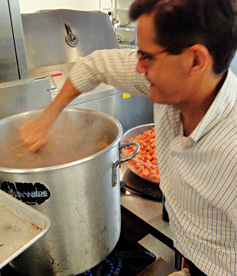 After I’d browned all the beef, I combined it with potatoes, garlic, celery, carrots, bay leaves, and crushed tomatoes in a stock pot that was probably three feet tall, and about the same in diameter. Commodious, yes, but unfortunately this kitchen had no stirring utensils large enough to circulate this tremendous vessel’s contents. Working with a ten-inch long spoon was like trying to blend a gallon of paint with a Q-Tip. I was forced to roll my sleeve up, and plunge my arm into hot fluid up to my elbow in an attempt to dislodge what was lowest and heaviest in the pot, thus keeping it from burning. Yeee-ouch! Each time, I yanked my doused forearm out just before it scalded, and rushed to the sink to run cold water over it. Large scale cooking, I’ve learned, is not for the faint of heart.
After I’d browned all the beef, I combined it with potatoes, garlic, celery, carrots, bay leaves, and crushed tomatoes in a stock pot that was probably three feet tall, and about the same in diameter. Commodious, yes, but unfortunately this kitchen had no stirring utensils large enough to circulate this tremendous vessel’s contents. Working with a ten-inch long spoon was like trying to blend a gallon of paint with a Q-Tip. I was forced to roll my sleeve up, and plunge my arm into hot fluid up to my elbow in an attempt to dislodge what was lowest and heaviest in the pot, thus keeping it from burning. Yeee-ouch! Each time, I yanked my doused forearm out just before it scalded, and rushed to the sink to run cold water over it. Large scale cooking, I’ve learned, is not for the faint of heart.
Morning turns into early afternoon. I mash all the potatoes by hand—I’d been unable to find a mixer—and combined them with two gallons of milk and thirty sticks of butter. I’ve just begun chopping pineapples when a group of young women and some executives from St. Patrick Center show up. An older woman in a pink cashmere sweater set is astonished by my techniques and stands watching me, as if I am doing open-heart surgery.
“I had no idea. I had absolutely no idea,” she kept saying.
Really? She’s never cut open a pineapple before?
I then talk to Krista McCann, and Amy Lampe, both in their early 30’s, who are new recruits to the Casserole Program. As McCann explains it, she decided it would be fun to get a group of her girlfriends together once a month, and cook in her kitchen.
“We drink some wine, we gossip,” she said, with a giggle. “We’ll usually make one extra pan of whatever we’re making, and then try it out ourselves.”
When I ask if they usually like what they’ve made, McCann pauses. “Let’s say, we’ve had to alter the recipes a little bit. We’ve added fresh spinach to the Spaghetti Bake. Now, we’re working on the King Ranch Casserole.” This last, she explains, is a Mexican-inspired dish involving black beans, tortilla chips, cheddar cheese, and both Cream of Mushroom and Cream of Chicken soup.
I’m quite giddy, as I’m about to see my first-ever dance of the Maypole.
Perhaps sensing my dismay, Lampe said, “Canned soup is convenient, but it is high in sodium. I’d like to think there is a better way…”
Later, I spoke to Lampe again and she told me that troubling her more than their recipe’s saltiness was the wide gap between chef and consumer the Casserole Program, quite unintentionally, can create.
“I mean, it’s great fun for all of us to meet over at Krista’s house. That is what makes this so easy to do. However, we are not interacting with the homeless people at all, because after we’ve made the casseroles, Krista comes down here to drop them off. We’ve discussed finding a date we can all gather to actually serve a meal, but we have been talking about it for months now, and haven’t been able to schedule anything yet. I guess we don’t know how to interact with needy people. That is the unfortunate truth. I mean, I see homeless people every day, and it’s always a struggle. Do I give them money, or will they buy beer? It gets confusing. But this, our cooking casseroles, is a very simple and conflict-free thing.”
I try to reassure her. “It’s complicated. You’re right. But, would it be better if you did nothing? You’re doing the best you can, and that has to be enough.”
Lampe doesn’t seem convinced.
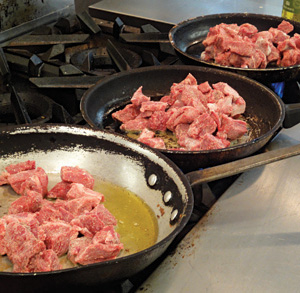 When the women leave, I begin to worry myself. I’d let Liz, Stephen, Mariah, Jeff and Inda go, and now I’m here alone. With no one to help me with the clean up, I struggle to operate the industrial-sized dishwasher, and get dirty pots in and out of deep sinks. The three fry pans I sauteed the beef in are hopeless. I decide to take these to Inda’s house and scrub them at my leisure, rather than try to get them clean without any steel wool or other scrubbing agents. There is no bucket or mop, so for about a half an hour, I’m on my hands and knees, crawling about with a roll of paper towel, doing my best to swab up the kitchen floor. I think of the advice I gave Amy Lampe. I’m doing the best I can…Yet, the floor still looks quite dirty.
When the women leave, I begin to worry myself. I’d let Liz, Stephen, Mariah, Jeff and Inda go, and now I’m here alone. With no one to help me with the clean up, I struggle to operate the industrial-sized dishwasher, and get dirty pots in and out of deep sinks. The three fry pans I sauteed the beef in are hopeless. I decide to take these to Inda’s house and scrub them at my leisure, rather than try to get them clean without any steel wool or other scrubbing agents. There is no bucket or mop, so for about a half an hour, I’m on my hands and knees, crawling about with a roll of paper towel, doing my best to swab up the kitchen floor. I think of the advice I gave Amy Lampe. I’m doing the best I can…Yet, the floor still looks quite dirty.
I arrive back at Inda’s house just in time to take a quick shower and suck down a beer. I’m quite giddy, as I’m about to see my first-ever dance of the Maypole.
Arrayed across sixty wooded acres in one of St. Louis’ prettiest and most affluent suburbs, the Villa Duchesne school is gorgeous enough to put many a small private college to shame. As Inda and I drive up, a crowd is gathering on a lawn shaped like a bowl behind the main academic building. Folding chairs are arranged in rings, up its slopes. This natural amphitheater is flanked on one side by the gothic pretensions of a large chapel built with a donation from Stan Musial (a.k.a. “Stan the Man”), a still-beloved baseball player who slugged out a record-breaking number of home runs during his many seasons with the St. Louis Cardinals in the 1940’s and 1950’s.
At the center of the lawn is a tall pole, a flower arrangement perched at its top, with long, cascading ribbons of yellow, blue, pink and green anchored down to the ground like guide lines on a circus tent. The crowd is overwhelmingly Caucasian and they’ve shown up in their best “we’re the 1%” attire. Men are wearing loafers without socks, and linen pants in obnoxious colors like tangerine and chartreuse. The women have on quilted jackets, Hermes scarves and Tory Burch ballet flats. Excitement is high. This is clearly the event of the academic year, in every way a much bigger deal than graduation itself. The seniors, Inda told me, had been practicing the intricate choreography for weeks, to the neglect of their studies, and nearly everything else in their lives. Gaggles of younger girls sit in the grass down front, presumably to get a better view of their older sisters. In every hand, there is a cell phone or digital camera, at the ready, to take photographs.
 Finally, the show begins. A pianist, making do on an electric keyboard, and accompanied by a lone violinist, launches into a fugue that sounds vaguely Mendelssohnian, like a deleted passage from his famous “Wedding March” in C Major. Through open doors at the back of the main building comes a stately procession of 80 young women, all dressed in white, floor-length evening gowns. I make a quick count of ethnicities represented, which is easy enough to do. 77 Caucasians; one Asian; two African-Americans. Each of the girls carries her own strand of English Ivy, maybe a yard or so long, which they hold out from their waists with stiff arms, as if it were a serpent that might bite. Around their waists are long sashes, made of the same colored ribbons as those draping from the Maypole.
Finally, the show begins. A pianist, making do on an electric keyboard, and accompanied by a lone violinist, launches into a fugue that sounds vaguely Mendelssohnian, like a deleted passage from his famous “Wedding March” in C Major. Through open doors at the back of the main building comes a stately procession of 80 young women, all dressed in white, floor-length evening gowns. I make a quick count of ethnicities represented, which is easy enough to do. 77 Caucasians; one Asian; two African-Americans. Each of the girls carries her own strand of English Ivy, maybe a yard or so long, which they hold out from their waists with stiff arms, as if it were a serpent that might bite. Around their waists are long sashes, made of the same colored ribbons as those draping from the Maypole.
Not that the Maypole is addressed immediately. No indeed, for quite some time, the young women did quadrilles and loop-the-loops, all the while brandishing their lengths of ivy. Moving in an ever-rotating pattern, soon enough, each young woman has paraded herself in front of every spectator once, twice, three times, and still more, until I lost count and began to grow impatient, then bored, then unkind. How could one resist the urge to compare and contrast? Some of the girls were quite svelte and had on enough make-up to look middle-aged; others possessed sufficient body fat and acne to appear adolescent. I began to guess which were the ones who harbored no greater ambition than to, some day, see their own daughter in this dance. Others looked like they were in on the joke, rolling their eyes ever so slightly at the absurdity of this performance.
Occasionally, Inda whispered a sotto-voce resume of a favorite student as she whirled past. (“See that one? With the dark glasses? She wrote a senior paper on the Anthony Burgess novel, A Clockwork Orange. It was brilliant!”)
I recalled my own high school graduation (class of 1975), when girls I knew were obsessed with making lengths of chain out of intricately folded and interwoven chewing gum wrappers.
I try to recall the names of these antique dance steps—pirouettes, gavottes, and ronds de jambes—most of which would not have looked out of place in the court of Henry VIII. These girls were offering themselves up to the crowd for appraisal, cavorting in such a way that we could admire the shape of their heads, shoulders, waists and hips, while they teasingly circled about the mighty phallic symbol of the Maypole. What was surreal, though, eventually grew quite tiresome. Finally, they all marched forward, laid down their ivy fronds, picked up a ribbon, and began to bob and weave about, their lengths of ribbon gradually beginning to sheath the Maypole in a diagonal checkerboard pattern.
“They never get it exactly right, but most people don’t notice, as you really have to have seen it a few times to know what you’re looking at,” Liz told me earlier in the day.
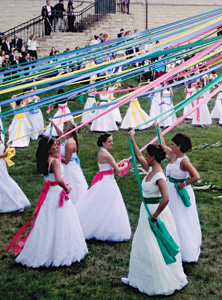 All the while, the “Mendelssohn” continued to play, over and over and over again. I thought about weaving, and Ariadne’s red thread she gave to help Theseus escape from the minotaur’s labyrinth. I recalled my own high school graduation (class of 1975), when girls I knew were obsessed with making lengths of chain out of intricately folded and interwoven chewing gum wrappers. Hundreds of feet long, these lariats had no worth other than all the time invested into making them. What could it all mean?
All the while, the “Mendelssohn” continued to play, over and over and over again. I thought about weaving, and Ariadne’s red thread she gave to help Theseus escape from the minotaur’s labyrinth. I recalled my own high school graduation (class of 1975), when girls I knew were obsessed with making lengths of chain out of intricately folded and interwoven chewing gum wrappers. Hundreds of feet long, these lariats had no worth other than all the time invested into making them. What could it all mean?
Just when I felt I would go mad, the Maypole ceremony came to an abrupt end, when the girls simply dropped their ribbons. The crowd cheered lustily, and everyone was invited to a reception out on the school’s front lawn. Here, a buffet of hors d’oeuvres was arranged; the most popular, by far, were slices of “candied” bacon.
I arrived at the St. Patrick’s Center bright and early the next morning. Anxiously tasting the boeuf bourgignon, I was delighted to discover its flavors had melded and deepened overnight. (Julia Child’s recipe promised this would be so, and I’d believed her.) I transfered its vast quantity into three smaller pots—though each, by any normal kitchen standard, were still gigantic. I placed the many trays of mashed potatoes in a warming oven. I got busy making a chiffonade of basil leaves that I planned to scatter on the mashed potatoes. All would be well, I thought.
Like any child of the American public school system, I’ve eaten my fair share of both Tuna and Chicken Tetrazzini, and I was hoping not to repeat the experience as an adult.
Davey disagreed.
Davey was in charge of heating the casseroles for that day, and he had been reassigned to assist me in getting the food we’d cooked onto the plates. After I showed him everything, he said, “looks mighty good, but it ain’t nearly enough. We ‘specting upwards of 275, maybe 300 peoples. I guess I’d best heat up some of them Chicken Tetrazzini.”
Davey didn’t mean to, I’m sure, but those last four syllables pierced my skin, just as surely as the arrows into St. Sebastian. Te. Tra. Zzi. Ni. Despite its exotic-sounding name, it is an American dish through and through, and is widely believed to have been invented around 1910, by a chef at the Palace Hotel in San Francisco, in honor of an Italian opera star, Luisa Tetrazzini. Made with cubed poultry or hunks of seafood, as well as mushrooms, almonds and spaghetti, it is usually bound together with a butter, cream and Parmesan cheese sauce that’s sometimes flavored with sherry. (Poor Louisa. Long forgotten, save for her association with a glob of gluey pasta.) Like any child of the American public school system, I’ve eaten my fair share of both Tuna and Chicken Tetrazzini, and I was hoping not to repeat the experience as an adult.
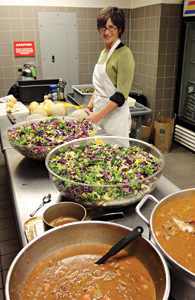 So, I set to work to prove Davey wrong. Laying into Inda like she was my personal slave, I demanded that we quickly make even more salad, and soon we were shredding cabbage into a blizzard of purple ribbons. Inda made another half-gallon of salad dressing. I chopped up extra canteloupes, adding them to the fruit salad. Somehow, too, we remembered to do all the final flourishes I’d planned—getting peas into the stew just before serving so they’ll still be bright green, determining just the right proportion of brown sugar to sour cream on each serving of fruit salad. I am teased by my friends and family about this mania of mine for “presentation” at dinners I serve in my own house. People think it absurdly fussy that I will wipe the edges of plates for errant droplets of sauce. To my mind, these things make a difference. Part of what stimulates the appetite is the eye. If something is served with care, it has a better chance of being savored by the diner.
So, I set to work to prove Davey wrong. Laying into Inda like she was my personal slave, I demanded that we quickly make even more salad, and soon we were shredding cabbage into a blizzard of purple ribbons. Inda made another half-gallon of salad dressing. I chopped up extra canteloupes, adding them to the fruit salad. Somehow, too, we remembered to do all the final flourishes I’d planned—getting peas into the stew just before serving so they’ll still be bright green, determining just the right proportion of brown sugar to sour cream on each serving of fruit salad. I am teased by my friends and family about this mania of mine for “presentation” at dinners I serve in my own house. People think it absurdly fussy that I will wipe the edges of plates for errant droplets of sauce. To my mind, these things make a difference. Part of what stimulates the appetite is the eye. If something is served with care, it has a better chance of being savored by the diner.
Kelly Peach was now at my side. “How shall we introduce you to our guests?” she asked. “Or, would you like to say something yourself?”
I pause for a moment, trying to think of both a polite, and politic, answer. I am, of course, no different from Amy Lampe, who so candidly told me of her hesitation to “interact” with needy people. Only, I’m not as honest as Amy, so I’m unwilling to admit how nervous I am to Kelly.
“Actually,” I said. “Why don’t we just let the food speak for itself?”
Kelly smiled, and I sensed she was, mistakenly, quite impressed with my modesty.
I am not modest. Rather, I am a coward.
Soon, I’ve gone through two pots of bourguignon, and still the line is long. I keep ladling, and ladling.
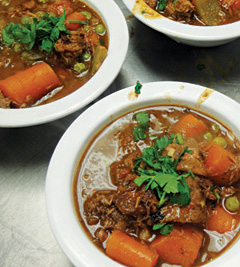 As we approached the noon hour, there is a great deal of excitement in the kitchen. To serve the food, Inda, Davey and me were joined only at the last minute by a few of the women who work in the St. Patrick Center’s administrative offices. All of them, alas, have opinions on the best way to “plate” the meal. Debate rages and things turn briefly tense until I propose that a small bowl be put onto the plate, into which the bourguignon will be ladled, with mashed potatoes and green salad alongside. Davey’s eyes widen. I belatedly realize this will increase the amount of dishes needing to be run through the dishwasher. Still, this suggestion carries the day, and a rolling partition separating a dining area from the kitchen sprang up with a rattling clatter. Dear God! There is a line of people, pressed close, winding all the way around the cafeteria and out the door.
As we approached the noon hour, there is a great deal of excitement in the kitchen. To serve the food, Inda, Davey and me were joined only at the last minute by a few of the women who work in the St. Patrick Center’s administrative offices. All of them, alas, have opinions on the best way to “plate” the meal. Debate rages and things turn briefly tense until I propose that a small bowl be put onto the plate, into which the bourguignon will be ladled, with mashed potatoes and green salad alongside. Davey’s eyes widen. I belatedly realize this will increase the amount of dishes needing to be run through the dishwasher. Still, this suggestion carries the day, and a rolling partition separating a dining area from the kitchen sprang up with a rattling clatter. Dear God! There is a line of people, pressed close, winding all the way around the cafeteria and out the door.
 Ladle in hand, I hover at the stovetop, filling soup bowls. Each bowl gets a scattering of chopped parsley, and is passed on to the front line. The fruit salad was already outside near the 100-cup coffee percolator, and people could help themselves to this. Every few moments, Davy places another stack of bowls on the edge of a stainless steel counter near the stove, and I keep plowing through them, serving up dish after dish after dish. I already have a blister on my right hand’s index finger from yesterday’s labors, and now my right wrist and upper arm begin to ache.
Ladle in hand, I hover at the stovetop, filling soup bowls. Each bowl gets a scattering of chopped parsley, and is passed on to the front line. The fruit salad was already outside near the 100-cup coffee percolator, and people could help themselves to this. Every few moments, Davy places another stack of bowls on the edge of a stainless steel counter near the stove, and I keep plowing through them, serving up dish after dish after dish. I already have a blister on my right hand’s index finger from yesterday’s labors, and now my right wrist and upper arm begin to ache.
Here we all are, eight of us, whirling around each other, in unrehearsed coordination. I think of what I saw the night before. This is our Maypole dance, I decide; our sacre du printemps.
Soon, I’ve gone through two pots of bourguignon, and still the line is long. I keep ladling, and ladling. Just as the last drop was served, the garage door rolls down, and we are closed for business.
“We served 287 people!” one of the women announces with great astonishment, as she gazes down at a clicker in her hand. We servers let up a cheer, and hugs are exchanged all around.
Suddenly, I am famished. I realize how altogether appropriate it is that I either have to go without food, or dine on a plate of chicken tetrazzini. Davey serves me, and I go out into the cafeteria to sit at one of the tables. As someone once said, hunger is the best recipe. I eat with gusto. The casserole is delicious!
Even though I’d made a point of not being introduced, among the diners there exists a general sense something different occurred at lunch that day, and the white man with his hair gelled firmly into place over in the corner may have something to do with it. And so, people began to drift over to offer opinions and criticism. One guy wants me to know my garden salad was a torture for him to eat, as he doesn’t have sufficient numbers of teeth to chew raw cabbage.
“You might want to keep that in mind, the next time you come here,” he says. “The mashed potatoes is fine, by the way. I has no problem with them.” As he talks, I notice his caved-in cheeks, and I spy a lone tooth poking out crookedly from underneath his upper lip.
An elderly woman who has her hair bobbed and dyed a vibrant shade of tomato red, counts off all the fruits she tasted in the salad, lingering with a smile on each finger. “And, there was something green—what was that?”
“Kiwi,” I said.
“Ki who?”
“Kiwi fruit. I think they are originally from New Zealand.”
“You don’t say!”
A very, very obese black woman named Angel grabs my elbow from behind with such force, I drop my fork. She gazes down at me scowling. “When I had a job, and some money of my own, I used to be able to eat like that. You brought back some powerful good memories.”
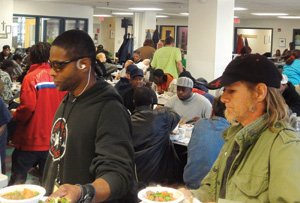 Finally, I chat with a young guy with wispy blonde hair that hangs lank to his shoulders. He has a surfer-stoner drawl. “People here are not used to those sorts of flavors, but I told them that this is what real food tastes like,” he said. This man has gorgeous blue eyes. He is very tan. I am about to compliment him on his ruddy glow and how healthy he looks, but then I realize what a fool I am. He’s not just back from St. Barths. This man is homeless. He’s out in the sun all day, not by choice, but by necessity.
Finally, I chat with a young guy with wispy blonde hair that hangs lank to his shoulders. He has a surfer-stoner drawl. “People here are not used to those sorts of flavors, but I told them that this is what real food tastes like,” he said. This man has gorgeous blue eyes. He is very tan. I am about to compliment him on his ruddy glow and how healthy he looks, but then I realize what a fool I am. He’s not just back from St. Barths. This man is homeless. He’s out in the sun all day, not by choice, but by necessity.
Whenever I cook for others, there is inevitably a moment like this, when I am brought up short by my facile assumptions crashing into the real world of poverty. It’s happening less, but there it is.
“Thank you,” I mumble. “I’m glad you enjoyed it.”



